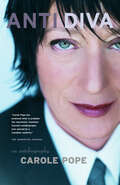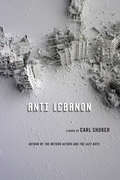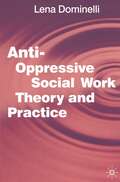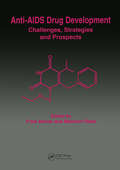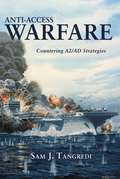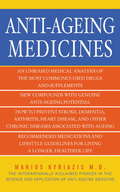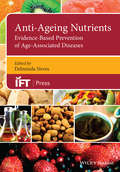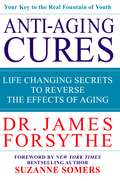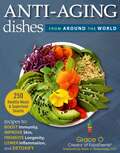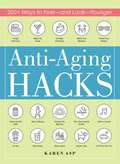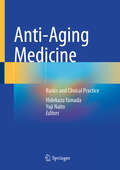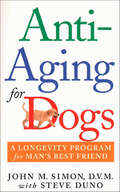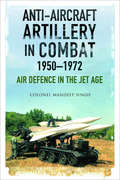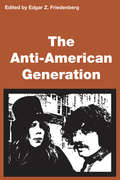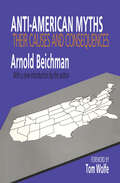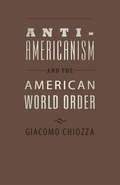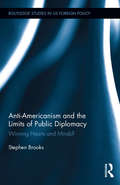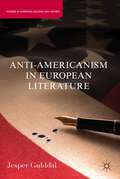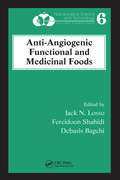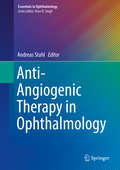- Table View
- List View
Anti Diva: An autobiography
by Carole PopeThroughout her career, Carole Pope has blazed a trail for the diva and anti-diva in all of us, and here she offers a no-holds-barred look at her adventures in the music scene – on the concert stage, in the recording studio, and in the bedroom. Known for ushering Canada from the punk movement of the 1970s to the new wave sound of the 1980s with Rough Trade, she candidly shares her thoughts on AIDS, sexuality and sexual politics, and the new breed of music divas that dominates the charts today.
Anti Lebanon: A Novel
by Carl ShukerIt is Arab Spring and the fate of the Christians of the Middle East is uncertain. The many Christians of Lebanon are walking a knife-edge, their very survival in their ancestral refuge in doubt, as the Lebanese government becomes Hezbollah-dominated, while Syria convulses with warring religious factions. Anti Lebanon is a cross-genre political thriller and horror story embedded within these recent events, featuring a multiethnic Christian family living out the lingering after-effects of Lebanon's civil war as it struggles to deal with its phantoms, its ghosts, and its vampires.Leon Elias is a young and impoverished Lebanese man whose older sister had joined a Christian militia and has been killed. He becomes caught up in the recent "little war" in Beirut, when the Shi'a resistance/militia Hezbollah takes over most of the city. In this milieu-the emptied streets of Christian east Beirut, the old shell-scarred sandstone villas, the echoing gunfire-he becomes involved, only partly by choice, in the theft of a seriously valuable piece of artisanal jewelry, and is bitten-like a vampire-by its Armenian maker.Events take a ghostly and mysterious turn as the factions jostling for power in Beirut begin to align against him and his family, and he is forced to flee the sullied beauty of that wonderful and pitiful country, in this story of love and loss, of the civil war and the Arabization of the "Switzerland of the Middle East," and of contemporary vampires-beings addicted to violence, lies, and baser primal drives.Carl Shuker is a remarkable writer. A storyteller in the tradition of Celine and J. G. Ballard, no one alive writes better sentences. Anti Lebanon will delight his fans and entrance anyone new to his fine work.
Anti Oppressive Social Work Theory and Practice
by Lena DominelliThis book, by one of the leading theorists of social work, tackles a subject of crucial importance to students and practitioners alike: how social workers can enable their clients to challenge and transcend the manifold oppressions that disempower them (whether through poverty, disability, mental illness, etc. ). It moves from a discussion of social work's purpose and ambitions to an exposition of theory and, from there, to the practice arenas of working with individuals, in groups, within organisations, and within a wider social and political context.
Anti-AIDS Drug Development
by Prem Mohan Baba MasanoriThis book covers the major arenas of drug development, providing understanding of the pros and cons of the various efforts of chemists and biologists to explore newer antiviral targets for HIV replication and to look for and design molecules that will have minimal toxicities.
Anti-Access Warfare
by Sam TangrediThe book is the definitive conceptual and historical introduction to the concept of anti-access strategies. Unlike current studies, it is not simply technology focused. Nor is it primarily intended as critique of the current Air-Sea Battle concept. It combines conceptual thinking with historical examples and potential scenarios in order to identify options for future defense planning.Strategies of "anti-access," also known as "area denial" (more recently combined into the awkward acronym "A2/AD") are presumed to be the primary threats to the employment of U.S. military forces in overseas crises. This presumption has gradually evolved into a joint concept of "operational access." Anti-access capabilities appear to be the current military posture of the People's Republic of China and Islamic Republic of Iran. The study of anti-access or area denial strategies for use against American power projection capabilities has strong naval roots-which have been largely ignored by the most influential commentators. In reality, denial of access was the Soviet Navy's operational objective during the Cold War. The first use of the actual anti-access term can be traced to a series of "anti-Navy" studies by the Office of Net Assessment designed to examine the ability of the U.S. Navy to carry out its Maritime Strategy and, later, "...From the Sea" strategic vision. Sustained long-range power projection is both a unique strength of U.S. military forces and a requirement for an activist foreign policy and forward defense. In more recent years, the logic of the anti-access approach has been identified by the Department of Defense as a threat to this U.S. capability and the joint force; countering it is one of the defense priorities identified in the President's directions issued this past January. In addition to potential regional powers, a number of think-tanks have suggested that non-state actors, such as terrorist organizations, are developing anti-access/area denial capabilities.The book's conclusions differ from most commentary on anti-access. Rather than a technology-driven post-Cold War phenomenon, the anti-access approach has been a routine element of grand strategy used by strategically weaker powers to confront stronger powers throughout history. But they have been largely unsuccessful when confronting a stronger maritime power. Although high technology weapons capabilities enhance the threat, they also can be used to mitigate the threat. Rather than arguing against reliance on maritime forces-presumably because they are no longer survivable-the historical analysis argues that maritime capabilities are key in "breaking the great walls."
Anti-Ageing Medicines
by Dr Marios KyriazisAn in-depth analysis of the benefits, limitations and side effects of the most commonly used anti-ageing medicines.
Anti-Ageing Nutrients
by Deliminda NevesAgeing is a complex, time-related biological phenomenon that is genetically determined and environmentally modulated. According to even the most pessimistic projections, average lifespan is expected to increase around the world during the next 20 years, significantly raising the number of aged individuals. But increasing life expectancy presents new problems, and industrialized countries are facing a pronounced increase in lifestyle diseases which constitute barriers to healthy ageing. Anti-Ageing Nutrients: Evidence-based Prevention of Age-Associated Diseases is written by a multi-disciplinary group of researchers, all interested in the nutritional modulation of ageing mechanisms. Structured in three parts, Part 1 looks at the cellular modifications that underlie senescence of cells and ageing of the organisms; the effects of energy restriction on cellular and molecular mechanisms and in the whole organism; and the epigenetic modifications associated with ageing. Part 2 includes chapters which discuss the nutritional modulation of age-associated pathologies and the functional decline of organs, with a focus on those primarily affected by chronological ageing. Part 3 summarises the knowledge presented in the previous chapters and considers the best diet pattern for the aged individuals. The book reflects the most recent advances in anti-ageing nutrition and will be a valuable resource for professionals, educators and students in the health, nutritional and food sciences.
Anti-Aging Cures
by Dr James Forsythe Foreward by Suzanne SomersAre you tired of searching for the fountain of youth? Well, look no more. In this book, Nevada medical oncologist Dr. James Forsythe, one of the worldOCOs leading anti-aging experts, reveals how to slow and even reverse the aging process. Based on meticulously researched clinical evidence, this book provides an account of revolutionary anti-aging treatments that can prevent the health conditions associated with getting old. The key to youth, good health, and vitality as we age comes from our bodyOCOs Master Hormone that naturally produces human growth hormone (HGH ). As we advance in years, the body produces less and less of this vital hormone and we begin to see and feel symptoms of the aging process. By rejuvenating the Master Hormone gland using a range of safe and natural Bio-Stimulators, as this book shows, we improve the quality and duration of the human lifespan, prevent heart disease and obesity, and maintain optimal health as we mature. The medically documented and proven benefits include: loss of body-fat mass, improved skin texture and tone, improved bone density, improved libido and sleep quality, and much more. Dr. Forsythe, who wrote the official United States government protocol for administering growth hormone to fight aging, describes how readers can harness the power of Bio-Stimulators safely, legally, and naturally, to combat the ravages of aging. The book also describes simple ways to release more growth hormone in your body by using combinations of everyday foods, exercise, and quality sleep. Backed by firm medical science evidence, Anti-Aging Cures will teach you how all of these natural cures for aging work their magic on the human body. "
Anti-Aging Cures
by Suzanne Somers James ForsytheAre you tired of searching for the fountain of youth? Well, look no more. In this book, Nevada medical oncologist Dr. James Forsythe, one of the world's leading anti-aging experts, reveals how to slow and even reverse the aging process. Based on meticulously researched clinical evidence, this book provides an account of revolutionary anti-aging treatments that can prevent the health conditions associated with getting old.The key to youth, good health, and vitality as we age comes from our body's Master Hormone that naturally produces human growth hormone (HGH ). As we advance in years, the body produces less and less of this vital hormone and we begin to see and feel symptoms of the aging process.By rejuvenating the Master Hormone gland using a range of safe and natural Bio-Stimulators, as this book shows, we improve the quality and duration of the human lifespan, prevent heart disease and obesity, and maintain optimal health as we mature. The medically documented and proven benefits include: loss of body-fat mass, improved skin texture and tone, improved bone density, improved libido and sleep quality, and much more.Dr. Forsythe, who wrote the official United States government protocol for administering growth hormone to fight aging, describes how readers can harness the power of Bio-Stimulators safely, legally, and naturally, to combat the ravages of aging. The book also describes simple ways to release more growth hormone in your body by using combinations of everyday foods, exercise, and quality sleep. Backed by firm medical science evidence, Anti-Aging Cures will teach you how all of these natural cures for aging work their magic on the human body.
Anti-Aging Dishes from Around the World: Recipes to Boost Immunity, Improve Skin, Promote Longevity, Lower Inflammation, and Detoxify
by Grace O.Nearly 300 Recipes that Feature the Healthiest Foods from around the World Chef and author Grace O has traveled the world in search of delicious, good-for-you foods. Her passion for discovering food treasures from the Blue Zones and elsewhere, where people live longer, healthier lives, is the driving force behind FoodTrients.com and her new cookbook, Age-Defying Dishes of the World. In her third cookbook, Grace O delivers all the hallmarks of her two previous award-winning cookbooks, and more. In addition to over 200 easy-to-make recipes using everyday favorites, exotic ingredients, and superfoods from around the world, Age-Defying Dishes of the World includes healthy resources, helpful guides, and tips for improving your lifespan and "health-span." Grace O&’s global approach to her age-fighting recipes ramps up the flavor profiles of each dish to entice food lovers everywhere. She takes classic recipes and gives them international twists with a few simple steps, creating very interesting meals. For example, people will love her global take on chicken soup with recipes developed with Chinese, French, Greek, Middle Eastern, Mexican, and Indian variations. She does the same thing with basic sauces, pesto, main dishes, pastas, and bowls, and includes recipes with African, Southeast Asian, Latin American, Polynesian, Scandinavian, European, and Australian ingredients. The book also features guides to key herbs and spices from around the globe, and to the top 50 foods for longevity, healthy sweeteners, cooking oils, ancient grains, and more. All proceeds from Age-Defying Dishes of the World will be donated to the Grace O Foundation, which supports educating the public about nutrition, working with other food-based non-profits, and participating in research that explores food and the diseases of aging.
Anti-Aging Hacks: 200+ Ways to Feel--and Look--Younger (Hacks)
by Karen AspPreserve your looks and your health with these 200+ easy strategies to age-proof your body and mind. Are signs of aging—or even just worrying about signs of aging—taking their toll on you? In Anti-Aging Hacks, you’ll find more than 200 easy, actionable tips and exercises you can implement right away to help age-proof your body and mind. Through straightforward, easy-to-understand language, you’ll learn how to preserve your appearance and health, as well as combat —or prevent—the most common ailments, conditions, and risks associated with aging. From protecting your skin from wrinkles and fortifying your diet, to strengthening your body with fun and easy exercises and staying mentally sharp with stimulating activities, to preserving a youthful glow, you’ll find all you need to know to stay healthy, strong, sharp, and youthful for years to come. A selection of anti-aging hacks include: -Sleeping on your back to reduce wrinkles -Wearing sunglasses to help prevent cataracts and macular degeneration -Slowing aging and improve health through intermittent fasting -Using skincare products with retinol -Reading for 30 minutes a day to increase your life span Embrace Anti-Aging Hacks as your own personal fountain of youth—in handy guidebook form!
Anti-Aging Medicine: Basics and Clinical Practice
by Hidekazu Yamada Yuji NaitoThis textbook considers aging a disease and summarizes the leading-edge research and fact on anti-aging medicine and the aging mechanism. It provides the basics and biology of aging science, followed by presenting clinical studies such as exercise, nutrition, mental health (brain, sleep), and treatment interventions. The book also discusses aging control and considers behavioral, environmental, and societal implications for healthy aging. The field of aging science is interdisciplinary, and there are much more uncertainties; thus, it is crucial to summarize what is currently known to set a foundation for future research. The International Classification of Diseases by the World Health Organization (WHO) has given the aging-related disease a subcode of XT9T. This trend advanced research of aging-related sicknesses and the concept that infirmities associated with old age can be controlled, such as cancer, dementia, and cardiovascular diseases. Basic research has progressed, and clinical applications have become available, resulting in significant social changes. As increased life expectancy is happening over the globe, we are facing unprecedented challenges, and anti-aging medicine is a key to treating population growth, environmental problems, etc., as problems for the entire planet. Anti-Aging Medicine: Basics and Clinical Practice is an English translation of the publication by the Japanese Society of Anti-Aging Medicine. It is an insightful source for healthcare professionals and scholars in anti-aging and geriatrics. It will attract pharmaceutical, Information Technology, and Artificial Intelligence industries associated with aging-responsive markets. The English translation of this book, originally in Japanese, was facilitated by artificial intelligence. A subsequent human revision of the content was done by the editors and authors.
Anti-Aging for Dogs: A Longevity Program for Man's Best Friend
by Steve Duno John M. SimonYou love your dog. Don't you want to keep him around for a good long time?You take steps to slow down your own aging process and stay as healthy and fit as possible-- now you can do the same for you beloved dog. Learn Dr. John Simon's amazing program for canine longevity in Anti-Aging for Dogs, and your best friend can live years beyond his normal life expectancy. Simple but effective changes in your dog's lifestyle, diet, exercise program, environment, and behavior can yield astounding results. In this invaluable manual-- the first of its kind-- well-known and respected veterinarian Dr. John M. Simon tells you how to put this powerful program to use, with essential advice about:* Ensuring that your dog gets the right exercise, grooming, and dental hygiene* Creating a safe, healthy home environment for your dog* Avoiding common canine behavioral problems* Programs for assuring optimal nutrition, digestion, and detoxification* Plus: helpful appendices on first aid, toxic substances, and health maintenance
Anti-Aircraft Artillery in Combat, 1950–1972: Air Defence in the Jet Age
by Colonel Mandeep SinghAn in-depth look at the combat performance of ground-based air defenses during the Korean War, Vietnam War, Middle East conflicts, and other campaigns. Though anti-aircraft artillery was extensively used in combat in the First World War, it wasn&’t until World War II that it came into prominence, shooting down more aircraft than any other weapon and seriously degrading the conduct of air operations. In the battle between the attackers and anti-aircraft artillery, the latter had the upper hand when the war ended. The post-war years saw a decline in anti-aircraft artillery as peace prevailed, and the advent of the jet aircraft seemed to tilt the balance in favor of the aircraft as they flew faster and higher, seemingly beyond the reach of anti-aircraft artillery. It would take all the hi-tech equipment and the guile and cunning that anti-aircraft artillery could muster to try and reclaim pole position. It is that story, of the tug of war between the aircraft and artillery, that forms the narrative of this book—as it traces the history of combat employment of anti-aircraft artillery from the Korean War, in effect the first Jet Age war, to the War of Attrition between Arab states and Israel when the missiles came of age, sending the aircraft scurrying for cover. Mandeep Singh&’s book is the first attempt to look at the performance of anti-aircraft artillery, incorporating the views, analyses and experiences of Soviet, Arab and South Asian Armies through the major wars between 1950 and 1972.
Anti-American Generation
by Edgar FriedenbergThis book examines the social atti-tudes that distinguish today's youth from their predecessors, identifies the sources of these attitudes in the social experiences of today's youth, and analyzes the stereotype implied in the term "Anti-American Generation." These essays show clearly that the issue between the dissenting, primarily middle-class youth and their elders and most of the working class (regardless of age) is a difference of opinion not about Americanism but about moral behavior and the scope of moral judgment. What distinguishes the generations is not so much their feelings about their country, as' their feelings about what people should do about their feelings and the role feelings should have in the conduct of one's life. The at-titudes of the young are largely in conflict with an older cultural tra-dition that promotes the subordi-nation of impulse and personal conviction to rational control for the sake of common purposes and future acceptability and effective-ness.
Anti-American Myths: Their Causes and Consequences
by Arnold BeichmanIn his probing new introduction to Anti-American Myths, which was initially published twenty years ago as Nine Lies About America, Arnold Beichman notes a powerful fact: what makes the United States unique is not only its military power nor its huge economy, nor even its great technological innovations. Rather, what differentiates the nation from virtually all others is that there is no large-scale territorial movement whose sponsors seek to secede from the country and to establish a new nation. And yet, anti-Americanism has characterized a small portion of ideologists whom Beichman refers to as radical egalitarians. These prophets of doom still abound. Everywhere the glib accusations are leveled: America is sick, racist, materialist, aggressive, decadent, and only violent revolution can save it. Even the collapse of the Soviet Union and of socialist regimes in Eastern Europe has not quelled the rhetoric of anti-Americanism. It is Beichman's aim to explain the roots of such persistent opposition to American society as presently constructed. Tom Wolfe in his Foreword shrewdly observes: "This is not a book 'about America'... it is a book that uses the subject of the United States as a device with which to explore the modern intellectual's retrograde habits of mind. Beichman finds nothing particularly amusing about what American intellectuals do to rationality and the English language, let alone the common weal, when they get on the subject of the United States. But I, for one, find his demonstration of the hash these men have made of the mother tongue extremely entertaining." When initially published, Beichman's classic was termed "powerful, persuasive and credible ... a laser beam of fact and reason" by the Los Angeles Times, and a "most valuable antidote to a lot of cliche thinking and cliche thinking and cliche writing" by the New York Times. Edwin McDowell, in his review for the WaH Street Journal reminds the reader that Beichman "is not a rightwinger bent on defining the status quo. .. but unabashedly a man of the left... an important figure in the international trade union movement."Anti-American Myths'' will be of interest to intellectual historians, political scientists, sociologists, and all readers interested in contemporary social and political affairs.
Anti-Americanism
by Andrew RossEver since George Washington warned against "foreign entanglements" in his 1796 farewell speech, the United States has wrestled with how to act toward other countries. Consequently, the history of anti-Americanism is as long and varied as the history of the United States. In this multidisciplinary collection, seventeen leading thinkers provide substance and depth to the recent outburst of fast talk on the topic of anti-Americanism by analyzing its history and currency in five key global regions: the Middle East, Latin America, Europe, East Asia, and the United States. The commentary draws from social science as well as the humanities for an in-depth study of anti-American opinion and sentiment in different cultures. The questions raised by these essays force us to explore the new ways America must interact with the world after 9/11 and the war against Iraq. Contributors: Greg Grandin, Mary Louise Pratt, Ana Maria Dopico, George Yudice, Timothy Mitchell, Ella Shohat, Mary Nolan, Patrick Deer, Vangelis Calotychos, Harry Harootunian, Hyun Ok Park, Rebecca E. Karl, Moss Roberts, Linda Gordon, and John Kuo Wei Tchen.
Anti-Americanism and American Exceptionalism: Prejudice and Pride about the USA (Routledge Studies in US Foreign Policy)
by Brendon O'ConnorThis book argues against the tendency to see America as the worst or best nation and instead presents a case for seeing anti-Americanism as a counterproductive prejudice. There are many reasons to criticise American policies, politics and even society, but a crucial distinction must be drawn between criticism and prejudice. Charting the development and adaptation of this anti-American tradition, O’Connor maintains that it is important to contextualise it within the particularities of the American experience and the global reach of the United States’ influence and power. He argues for a move away from stereotypes and caricatures towards more specific and profitable discussions about American actions and policies. Offering precise and useful ways of understanding anti-Americanism and American exceptionalism that place the terms in their relevant political contexts, this volume is a useful and engaging resource for those researching or studying American politics and ideology, foreign policy, American culture and international relations.
Anti-Americanism and the American World Order
by Giacomo ChiozzaNews stories remind us almost daily that anti-American opinion is rampant in every corner of the globe. Journalists, scholars, and politicians alike reinforce the perception that anti-Americanism is an entrenched sentiment in many foreign countries. Political scientist Giacomo Chiozza challenges this conventional wisdom, arguing that foreign public opinion about the U.S. is much more diverse and nuanced than is generally believed. Chiozza examines the character, source, and persistence of foreign attitudes toward the United States. His findings are based on worldwide public opinion databases that surveyed anti-American sentiment in Islamic countries, Europe, Latin America, Africa, and East Asia. Data compiled from responses in a wide range of categories—including politics, wealth, science and technology, popular culture, and education—indicate that anti-American sentiments vary widely across these geographic regions. Through careful analyses, Chiozza shows how foreign publics balance the political, social, and cultural dimensions of the U.S. in their own perceptions of the country. He finds that popular anti-Americanism is mostly benign and shallow; deep-seated ideological opposition to the U.S. is usually held among a minority of groups. More often, Chiozza explains, foreigners have conflicting attitudes toward the U.S. He finds that while anti-Americanism certainly exists, the United States is equally praised as a symbol of democracy and freedom, its ideals of liberty, equality, and opportunity applauded. Chiozza clearly demonstrates that what is reported as undisputed fact—that various groups abhor American values—is in reality a complex story.
Anti-Americanism and the Limits of Public Diplomacy: Winning Hearts and Minds? (Routledge Studies in US Foreign Policy)
by Stephen BrooksContrary to the view held by many who study American foreign policy, public diplomacy has seldom played a decisive role in the achievement of the country's foreign policy objectives. The reasons for this are not that the policies and interventions are ill-conceived or badly executed, although this is sometimes the case. Rather, the factors that limit the effectiveness of public diplomacy lie almost entirely outside the control of American policy-makers. In particular, the resistance of foreign opinion-leaders to ideas and information about American motives and actions that do not square with their pre-conceived notions of the United States and its activities in the world is an enormous and perhaps insurmountable wall that limits the impact of public diplomacy. This book does not conclude that public diplomacy has no place in the repertoire of American foreign policy. Instead, the expectations held for this soft power tool need to be more realistic. Public diplomacy should not be viewed as a substitute for hard power tools that are more likely to be correlated with actual American influence as opposed to the somewhat nebulous concept of American standing.
Anti-Americanism and the Rise of World Opinion
by Monti Narayan DattaIn recent years, the US has seen its public popularity ratings around the world plummet under the presidency of George W. Bush, and subsequently soar upon the election of Barack Obama. The issue of anti-Americanism has received considerable attention from policy-makers, pundits and scholars alike. It is perhaps surprising then that systematic empirical studies of its consequences are still few and far between. Drawing from a wealth of research data, interviews and surveys of social media, this book directly examines pro- and anti-American views and asks what we can learn about the nature and impact of world opinion. By treating anti-Americanism as a case study of public opinion at work, Professor Datta reveals how we can better understand the relationship between global citizens and their political leaders, and concludes that anti-Americanism does in fact substantially impact US security, as well as its economic and political interests.
Anti-Americanism in Europe: A Cultural Problem (Hoover Classics Ser.)
by Russell A. BermanIn his analysis of Europe's ambivalence toward jihadist terror and the spread of aggressive Islamism, with particular emphasis on the European responses—or lack thereof—to this violent anti-modernism, Russell A. Berman describes how some European countries opt for appeasement and apologetics, whereas others muster the strength to defend their way of life and stand up for freedom. He describes a complex continent of different nations and traditions to further our understanding of the range of reactions to Islamism.
Anti-Americanism in European Literature (Studies in European Culture and History)
by Jesper GulddalPursues the hypothesis that fictional literature has been instrumental in the development and dissemination of European anti-Americanism from the early 1800s to today. Focusing on Britain, France and Germany, it offers analyses of a range of canonical literary works in which resentful hostility towards the United States is a predominant feature.
Anti-Angiogenic Functional and Medicinal Foods
by Fereidoon Shahidi Debasis Bagchi Jack N. LossoThe ability to regulate and manipulate the generation or remodeling of blood vessels is key to the successful treatment of many chronic diseases, both oncological and non-oncological. Several bioactive compounds present in human diets are now known to exert an inhibitive effect on the either the signaling or construction of new blood vessels. The i
Anti-Angiogenic Therapy in Ophthalmology (Essentials in Ophthalmology)
by Andreas StahlThis book provides a concise overview over the pathology of retinal angiogenic diseases and explains why anti-angiogenic therapy is effective in so many patients. The reader is guided through the various clinical indications for anti-angiogenic therapy and made aware of its merits as well as current challenges and limitations. It is explained how, since its introduction for the treatment of exudative age-related macular degeneration in 2006, anti-angiogenic therapy has revolutionized the way in which we treat a range of ocular diseases. All of the authors are established experts in their respective fields who share their extensive knowledge and clinical experience with the reader. This book is both a valuable introduction to anti-angiogenic therapy in ophthalmology and a day-to-day companion for all ophthalmologists seeing patients with some of the most prevalent retinal diseases.
